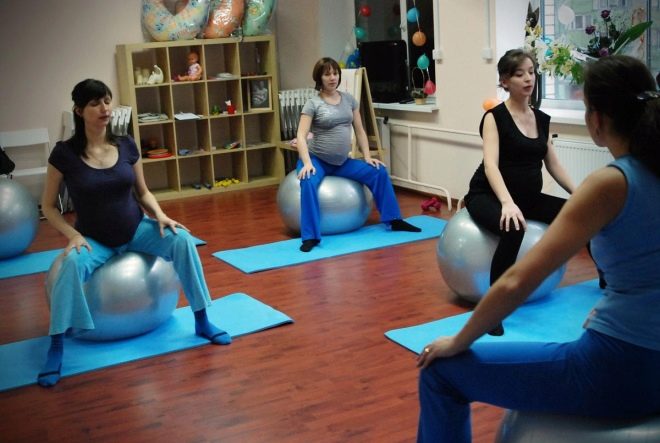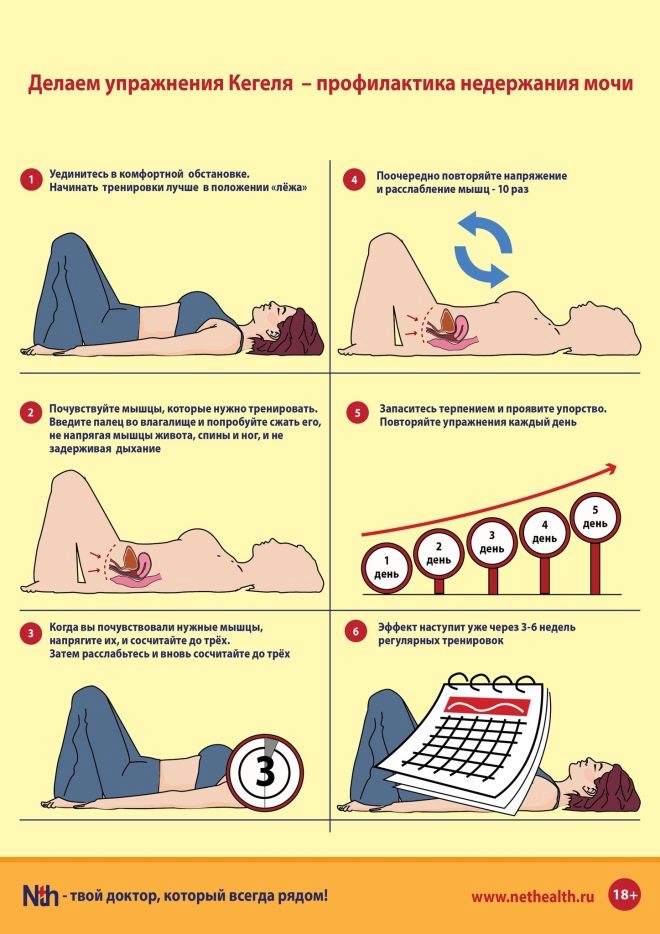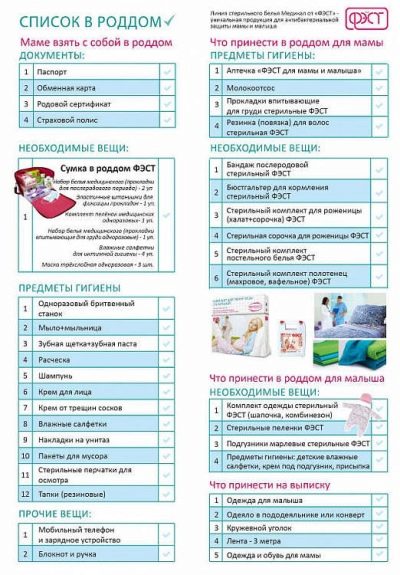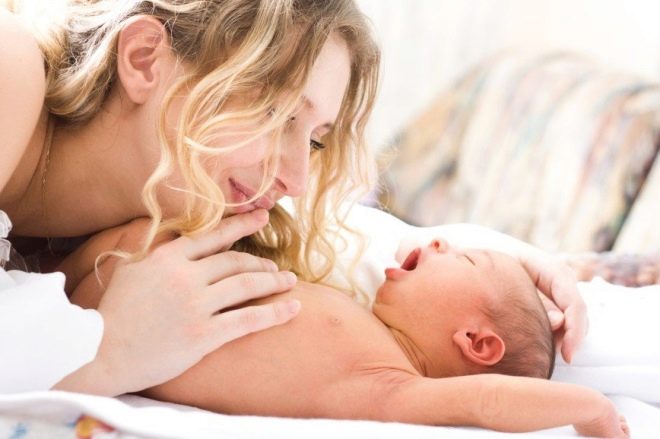Preparing for childbirth: everything you need to know pregnant
Experienced mothers know that much depends on how responsibly the preparation for childbirth was organized - partly the very process of birth of the baby, and the postpartum period. In the body of a woman, all organs and systems begin to prepare for the upcoming births almost from the first days of the “interesting situation”. These are physiological, hormonal, cellular processes, the task of which is to ensure the carrying and the subsequent birth of a child. Not less painstaking preparatory work is required from the woman herself, who is preparing to become a mother. In this article we will describe how to properly and correctly prepare for childbirth, what to provide.
Do I need to prepare?
Preparing for childbirth in advance is important for several reasons and preparation should be carried out in several directions. Childbirth is always a great stress, which sometimes prevents a woman from giving birth easily, without tears and injuries. The stronger the stress, the higher the likelihood of generic complications. When fear, in panic in women giving birth to muscle clamps that prevent the rapid birth of a child. On this statement were based numerous works of scientists, doctors from around the world, as a result of which the programs “Births without pain and fear”, “Painless births” and others appeared.
The more relaxed and confident a woman will be during pregnancy and childbirth, the more correctly, easily and with minimal pain the birth of the child will pass.
Preparation for childbirth pays great attention to obstetricians of all countries. In some cases, pregnant women are required to attend courses and schools for women “in position”. In Russia, courses for future mothers - this is a purely voluntary matter; when entering the obstetric institution, no one will ask for a certificate of completion of the preparatory courses. or trust the cause of the case - it is up to the woman herself.
In the generic process a lot of psychosomatic factors: fear, fear, unwillingness to experience pain, waiting for this pain, the opinion that it is obligatory and inevitable, can significantly complicate childbirth. While proper breathing, the readiness of the birth canal and all the muscles of the body will help to have a baby faster. Properly selected things and documents, a reasonably organized space at home will make the first days after the birth of the child more comfortable for everyone.
Many people are interested in who needs training. The answer is quite simple - any pregnant. But to a greater degree - primiparous, pregnant twins or triplets, women who give birth to a second or third child after a long temporary break, as well as to those who choose partner births.
Training includes physical exercise, some specific procedures, and psychological training.
And also we should not forget about the practical side of the issue - the right things for the mother and the child have not disturbed anyone yet.
Getting ready physically
Physical fitness for the parturient is very important. Women with low muscle tone, with obesity, often suffer from complications in childbirth and in the early postpartum period, so the preparation of muscles should be done from the very beginning of pregnancy, and better before it occurs.Some, seeing two strips on the test, deliberately refuse to visit the gym and other physical activities, stop walking, believing that for the unborn child it is the state of maternal rest that is most preferable. But this opinion is erroneous. To prepare the body for childbirth lying on the couch is impossible.
No one requires a woman to set Olympic records and exorbitant physical activity. In the first trimester of pregnancy, which is considered to be the period of greatest risks, in general, it is considered better to reduce the load to a minimum, but not to abandon it altogether - fortifying gymnastics, walking on foot will be useful to all pregnant women, even if the woman does not was engaged.
For pregnant women, there are special physical groups - they work at the pools, in most sports centers. You can engage in a group with other future mothers. Especially useful for preparing muscles for childbirth yoga and Pilates. As well as invaluable benefits can have swimming and water aerobics. Being in the water will help the baby to take the correct position in the uterus.
Any exercise in water or on land should be comparable to the duration of pregnancy. A woman should not tire, the load should not be a burden, cause muscle pain or discomfort. To physical training can be attributed, and respiratory techniques that contribute to relaxation during childbirth, an increase in the intensity of blood flow, prevention of hypoxia during childbirth.
Proper breathing not only facilitates the task of childbirth, but also reduces pain during labor pains. It is on the respiratory techniques that all the programs of the “Birth without pain and fear” are based today.
On the proper breathing technique shot a lot of video.
Moral readiness
Psychological prenatal preparation is very important. Often it is fear that becomes the cause of anomalous labor activity, weakness of labor forces. Defeating fears and anxieties is important so that childbirth goes well and quickly. The main difficulty lies in the fact that the girl almost from childhood is hammered into the head that giving birth is painful and difficult. There are such scenes in films, there are negative examples in literature, even in classic children's fairy tales, where the queen dies during childbirth without suffering a pang. As a result, a girl, a girl, a woman forms a stable block that starts the processes of animal horror before childbirth.
This may sound strange, but there are almost no pain receptors in the tissues of the uterus, so birth pain exists only in the head of the woman. The more she is afraid, the more pain will be - this is the basic rule of hypnotherapy before childbirth, which was practiced in the USSR, and now the methods of psychologists and psychiatrists are based on it.
It is foolish to demand the determination of a special forces intelligence officer and the same high pain threshold from a pregnant woman. But psychologists in antenatal clinics, psychotherapists in any clinic, public or private, can reassure a woman and convey to her the principles of hypnosis. You only need to contact. And the sooner the better, because the rapid course of psychological preparation in the third trimester is not as effective as planned long preparation.
You can do psychological training and independently, and you need to know what it is made of.
- The study of the theory - the processes and stages, all that concerns childbirth. How are the fights, attempts, how to behave at one stage or another, how to breathe, when and why, when to push, and when to relax. The better a woman is theoretically grounded, the better she behaves in a delivery room. When studying the theory, you need to use materials from reliable sources and avoid reading women's forums, where the information is often not true. Moreover, a pregnant woman has absolutely no need for other people's negative stories and examples.You can ask the obstetrician-gynecologist in the antenatal clinic to give advice on the choice of literature. The doctor will always advise which books for pregnant women will be most useful in light of preparing for childbirth.
- Autotraining. A woman who repeats herself every day that everything will be fine, will definitely believe in it. This confidence will give peace of mind. A woman will not perceive the onset of labor as a catastrophe, and childbirth as an ordeal. Childbirth is a process approaching a meeting with a beloved and long-awaited baby, and not at all “nature's mockery of the female body”. The body of every woman on the planet has everything you need to have a baby. This should not be forgotten. Trust in your own body and confidence in a positive outcome is half the success.
- Changing ideas about birth pain. Above it was said that pain has a psychogenic origin, which means it can be minimized with proper psychological preparation. The natural process of childbirth is not a disease, not an emergency. Here are useful methods of respiration in childbirth, for example, breathing according to Sausage, as well as other methods of natural anesthesia, which are taught in courses.
- Simulation of the situation. A woman in her own imagination can lose her own childbirth many times - to imagine how she endures contractions, how to push, how a baby is born. At the same time, it is important to imagine everything from a positive point of view. It is believed that any woman is mentally able to program the course of her own labor. Waiting for pain and horror leads to painful, difficult, long labor. A light and positive attitude to a completely natural process leads to an appropriate reality.
- Partnership childbirth. Childbirths with an assistant from among relatives and close people, whom the woman fully trusts, increase the comfort of staying in the patrimonial chamber and labor hall. If the decision is made on joint childbirth, you need to begin joint training, both psychological and physical. A partner in the maternity hospital can be very useful - he will massage between contractions, remind you when and how to breathe, and help you to take the best posture for easier transference of contractions.
- Trust in the medical staff. A very large psychological effect on a pregnant woman is placed on a doctor who will give birth or do a planned cesarean section. If a woman completely trusts a medical specialist, the stress level during hospitalization decreases tenfold. Therefore, it is important to choose the doctor with whom it will not be scary to go to the hospital or operating room.
Important! If you independently put your thoughts and feelings in order, it is necessary to turn to a psychologist. In antenatal clinics, at maternity hospitals and perinatal centers, the assistance of such specialists is completely free.
Willingness to the birth canal
During physiological labor, the load on the pelvic floor muscles is always incredibly high. The Kegel gymnastics complex will help reduce the risk of injury to the perineum, tears, and weak dilatation of the cervix. Exercises to strengthen the pelvic floor should be done with the permission of the doctor. If a woman does not have cervical insufficiency, threatened miscarriage or premature birth, an obstetrician-gynecologist may well allow her to practice such a complex.
Kegel exercises are a set of muscle exercises for the muscles of the vagina and pelvic floor, as well as for the muscles and sphincter of the anus. It helps to strengthen the corresponding muscles and is an excellent prevention of tears and postpartum hemorrhoids.
For the preparation of the birth canal in the third trimester, especially in the last days before birth, it is recommended conduct light massage with natural oil, which will include massaging the external genital organs to increase the elasticity of the skin and muscles of the perineum.
To relax the cervical round muscle 2 weeks before birth, some pregnant women are advised to take “No-Shpu." This effective antispasmodic helps the neck to better prepare for generic disclosure.
Mammary glands and forthcoming feeding
So that after the birth of the baby there are no problems with its feeding, experts advise to prepare the mammary glands in advance. Breast preparation should be a compulsory procedure, it can be taken at home, independently, since such preparation in itself is not difficult. Of course, a woman cannot influence the timing of the arrival of permanent milk. This process is caused by the production of the hormone prolactin. But to prepare your own nipples for breastfeeding - the task of the future mother. Cracks, painful sores on the nipples often stop the process of feeding the baby to the event rather painful. In order to prevent them, a woman is advised to approach breast hygiene properly even during pregnancy, especially when colostrum begins to be produced.
It is necessary to wash the breasts with warm water, without soap, at least twice a day. Supporting bra for pregnant women will ease the unpleasant heavy feelings that accompany the increase in the number of lobes of the mammary gland in the process of carrying a child.
To strengthen the mammary glands as part of their preparation, it is recommended to take a contrast shower daily and wear liners in the bra.
For tips on rubbing the nipples with a rough towel, massaging them, you need to consult a doctor - excessive stimulation of the nipples leads to an increase in the level of oxytocin in the body, which can cause premature labor. In the obstetrics of the Soviet period, such recommendations actually took place and were used mainly in the late stages of pregnancy. Modern obstetrics has a slightly different view on this matter - you can only prepare nipples with massage and stimulation for women who have a pregnancy without complications or pathologies.
Technique of attaching a child to the chestif a woman is going to give birth to a firstborn, it is also worth exploring beforehand. The medical staff doesn’t have enough time in every maternity hospital.
It is always easier for those who are alternate with putting a child in - there is an appropriate experience. Active preparation of the breast for the upcoming breastfeeding is recommended to engage no earlier than the 38th week of pregnancy, whereas hygienic requirements for breast care are in effect from the very first months of gestation.
What are the courses taught?
Free courses for pregnant women - this is not an event for a tick, as some people think. This is a great opportunity to ask all the sore questions not to faceless advisers on the Internet, but real graduates. Obstetrician-gynecologists, pediatricians, neonatologists, psychologists and specialists in social services for the population conduct classes in the school for preparing for childbirth.
Thus, training in such courses is multifaceted and very interesting. Women are told how childbirth begins, how contractions develop, how to ease them, how to behave in the process of trying, how the early recovery period after childbirth goes, what recommendations should be followed to make rehabilitation easier and quicker.
Pediatricians and neonatologists will talk about how to care for a baby in the first days of his life, how to feed a baby, how to handle an umbilical wound and prevent diaper rash. Psychologists will help to tune in childbirth positively and avoid postpartum depression, and social service experts will advise on family-related benefits and payments in connection with the birth of a baby and tell you how quickly to arrange them.
If partner deliveries are planned, both partners must attend classes. If the husband is expected to be present, then he will be trained to do a relaxing massage for his wife; effective poses will be shown for partner births, in which a woman can wait out another labor contraction. As well as on the courses, the partner will be provided with a list of tests and examinations that need to be done in order to be admitted with the woman in the hospital walls. Lectures are held both in the daytime and in the evenings, it will be convenient to attend them both to those who work or study, and to those who are already on maternity leave and have plenty of free time.
How to choose a hospital?
Previously, women did not have the right to choose; a woman in labor was hospitalized either at the maternity hospital at the place of residence, or at the maternity hospital on duty if delivered by ambulance. Since 2006, every pregnant woman has the right to independently choose a maternity hospital or a perinatal center where she wants to give birth to her child. Such a right is supported by a birth certificate. He is given out in the antenatal clinic where a pregnant woman is observed along with a sick leave when she is on maternity leave.
If childbirth is planned on a fee basis, then there is no need for a generic certificate. A woman will be able to negotiate conditions with the management of the chosen maternity hospital independently. - A contract for paid medical services usually implies the presence of a certain doctor or midwife at birth, a superior chamber before and after delivery, the use of epidural anesthesia not due to the testimony of the puerperal woman, presence at the birth of a partner, free visit of the puerperal in a separate box of relatives.
The same services, except for free visits by relatives and the VIP chamber, can be obtained free of charge, but on condition that the obstetrician is on duty on the day when the birth begins and the presence of the partner will be allowed by the hospital management. When choosing a maternity hospital, a woman can be guided by her own preferences, reviews of other pregnant women and puerperas.
It does not hurt to visit the chosen obstetric institution and clarify the following questions:
- conditions for prenatal and postnatal stay - which chambers, for how many places, where the bathroom is located, and if there is a shower;
- conditions of stay of children - joint with mothers or separate;
- qualification of doctors and obstetricians, qualification of pediatricians, anesthesiologists;
- equipment and equipment - is there any necessary equipment in the maternity hospital to help children and mothers in case of unforeseen dangerous complications?
Consider the remoteness of the hospital from the place of residence - think about relatives, because they visit you almost daily.
In the selected maternity hospital you need to sign the exchange card after 30 weeks of pregnancy. As well as a woman there will give a memo about what documents and things you need to collect with you for hospitalization.
Collecting things
There are universal lists of things for the hospital, but in each obstetric institution the list of permissible items may vary. Therefore, be sure to ask the staff of the selected hospital, what you need and what you do not need to be taken with you to a particular institution.
On average, the lists are quite similar. The bag of the parturient woman in its classic version consists of three groups of things:
- For childbirth - the list is individual.
- For women in the postpartum period. Washable slippers, a nightgown, a pack of puerperal pads, a bathrobe, a cup and spoon, as well as toilet paper, soap, a toothbrush and toothpaste are usually needed to stay in the maternity hospital.
- For a child. For baby care, you need to take the smallest diapers for newborns, powder, baby cream, several vest and sliders or diapers made from natural fabrics. A breast pump may also be useful.
The set of necessary documents is always the same regardless of the chosen maternity hospital. It includes:
- passport;
- policy;
- birth certificate;
- exchange card;
- medical card from the clinic (if there are concomitant chronic diseases);
- affiliate health certificate for partner childbirth.
Some obstetric hospitals also require a copy of the sick-list, the woman who handed over the original, when going on maternity leave, to the accounting office at her place of work.
Recently, doctors have strongly recommended that women take a pair of medical compression stockings with them to give birth to prevent complications with the vessels and veins of the lower extremities. It is important not to forget your mobile phone and charger to it, you can also take a book or magazine to pass the free time with benefit.
If there is a caesarean section
By hospitalization before a planned operation, if it is shown, you need to get serious. The referral to the maternity hospital needs to be arranged at the 38th week of pregnancy, because the operation itself is carried out after 39 weeks.
It is necessary to go to the hospital in advance, because before the operation a woman is carefully prepared in the maternity hospital - they do the necessary examinations, tests, choose the method of anesthesia.
To the list of things for a woman who is sent for a planned operation, be sure to add a disposable razor, disposable diaper and compression stockings of the second degree of compression. If desired, a woman can also purchase and take with her a postpartum postoperative bandage, which will facilitate the recovery process after a maternal surgical intervention.
Useful tips
When preparing for the upcoming birth, a woman must necessarily enlist the support of the attending physician, with whom she is registered. He needs to be fully trusted. Only he can answer with great precision that a particular pregnant woman can drink from a headache, whether it is necessary to drink a decoction of raspberry leaves and others before giving birth to her.
"Dowry" for the baby, many are trying to collect in advance. This point of preparation really needs to be given special attention. But everything needs to be done in advance so that it does not happen that in the last days before the birth, instead of relaxing, the woman will run around the children's shops.
According to women, after appropriate planned training, which covers all these aspects, it is easy and even noticeably quieter to go to the maternity hospital than spontaneously in the hope of a good outcome. Of course, it is impossible to foresee all possible situations, all possible complications in advance — neither the doctor nor the pregnant woman. But a woman should remember the main thing - she is in safe hands. If something goes wrong, she will definitely be helped. Modern medicine is at a fairly high level, so infant and female mortality during childbirth is now extremely low, and the percentage of complications is decreasing.
What thinks Dr. Komarovsky about preparing for childbirthlook in his transfer.




























